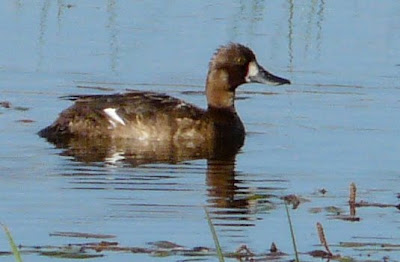Normally Hooded and Scott's Orioles nest at our house. Bullock's Orioles come and go, but usually nest elsewhere in the Portal area––until this year. I've been really pleased in recent days to see a male Bullock's here at the house, carrying food. Then this morning, Alan spotted the focus of the oriole's concern: he was dancing attendance on a juvenile Bronzed Cowbird!
Bronzed Cowbird juvenile (Photos by Narca)
Female Bullock's Oriole finds caterpillar for cowbird
I went straight to the Birds of North America account, written and revised by Peter Lowther and Kevin Ellison, to see what more I could learn, beyond a general impression that Bronzed Cowbirds favor orioles as hosts.
Male Bullock's Oriole (Pen & ink by Narca)
The Bronzed Cowbird has only been known in Arizona for the past 100 years, and in the past 50 years its range expansion in the US has been vigorous, as land was cleared for agriculture and golf courses (a favored habitat!)––although, so far, nothing else has matched the tidal wave that we've seen of Eurasian Collared-Doves! Now there are scattered records of the cowbirds as far north as Canada.
Bronzed Cowbird's primary range in the US includes the Colorado River corridor between California and Arizona; about a third of Arizona; New Mexico from the bootheel northward a ways; southern Texas; and a small patch of southeastern Louisiana-southern Mississippi. Southward, their range reaches through Mexico and Central America to Colombia.
Their breeding behavior is interesting: the female cowbirds converge in areas of host nests, attracted by the songs of the host male. The Bronzed Cowbirds usually lay their eggs about a quarter-hour before sunrise and after sunset, and only need about 10 seconds to accomplish the job. Often several female cowbirds lay in a single nest within a 24-hour period. The timing is important, because the cowbirds must synchronize their egg-laying with the hosts' egg-laying. A study by M.D. Carter (published in the Condor in 1986) found that cowbird young did not survive if they hatched more than 48 hours after the host's young. Cowbirds often pierce any host or cowbird eggs already present in the nest, an action that could prompt the host to lay again and help to achieve synchronized hatching. Once a female cowbird has laid in a nest, she avoids returning.
Where Bronzed and Brown-headed Cowbirds overlap, host nests have been found containing the eggs of both species! A few host species like Couch's Kingbird, Northern Mockingbird, and Red-winged Blackbird regularly eject cowbird eggs, and Hooded and Orchard Orioles can foil access to their nests. Maybe that's why the Hooded Orioles in our yard will sometimes suspend their woven baskets from a hook (intended for suspended plants) under our eaves: I can just imagine the gyrations a big cowbird would have to go through to get an egg into that dangling nest!
Northern Mockingbird (Pen & ink by Narca)
Researchers found Bronzed Cowbirds laying in the nests of 101 host species, ranging in size from Green Jays to Golden-cheeked Warblers. The list includes Summer Tanagers, Red-crowned Ant-Tanagers, and Orange-billed Nightingale-Thrushes. Bronzed Cowbirds often bestow their favors on orioles, but where orioles are rare, they seem to favor finch hosts, like Northern Cardinals and Olive Sparrows.
Golden-cheeked Warbler (Pen & ink by Narca)


























